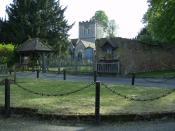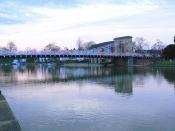Joseph Conrad's Heart of Darkness has undergone so much scrutiny since its publication in 1899 its story almost loses its luster unless one has a little background before diving into the novella. Conrad's style lends itself to scrutiny, though; only two of the characters bear actual names (Kurtz and Marlow), and even the bulk of the story's setting remains ambiguous: we are merely set on Marlow's journey along an indeterminable distance up the African Congo.
Ambiguity makes quite a name for itself throughout Darkness: the initial purpose of the four sailors aboard the Nellie; the name of Marlow's employer, "the Company;" the name of virtually everyone who crosses Marlow's path, excepting Kurtz; the length of time it takes for Marlow to undertake his quest into the unknown territory of Africa in search of Kurtz; and, most important to us, Marlow's obsession with obtaining, meeting and "talking with" Kurtz (Conrad, 63) -- an obsession one feels compelled to label queer (if not outright homosexual), though Conrad does his best to make sure the reader doesn't notice.
Why hide Marlow's sexual orientation, though, from the audience? The reader must consider who Conrad's audience would have been in 1899. Though it would be foolish to assume labels of a homosexual nature were as blatant or recognizable in the late nineteenth and early twentieth centuries as they are today (Ruppel, 153), it would be equally foolish to suggest same-sex preferences between men were ever openly acceptable in English society. "The concept of Marlow 'exploring' another man ... might well have been construed as homoerotic by Conrad's conservative, homophobic, white male ... readership" (Wilson, 106). Though the women were out of it (Conrad, 64), as Marlow says it, and men spent much of their time in proximity to each other -- away from...


